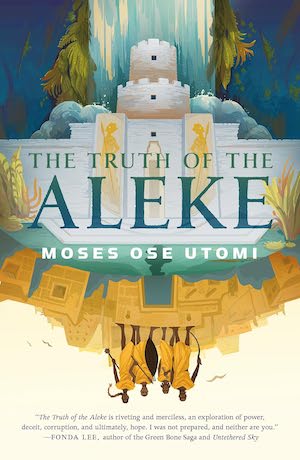With The Truth of the Aleke, Moses Ose Utomi jumps ahead half a millennium after the events of the first novella, The Lies of the Ajungo. Once more we see a young man perched at the edge of fate, a corrupt empire lying to its people, and friends turned enemies in a striking betrayal. Once more, the truth is a lie and lies become truth.
In the City of Truth, Osi is a Junior Peacekeeper. He dreams of becoming a Truthseeker and a hero to his people. For generations, they have battled the Cult of Tutu and their cruel leader the Aleke. Peacekeepers defend the city while Truthkeepers battle the enemy. During an attack on his city, Osi makes a dangerous choice he will eventually regret. He and the other Truthseekers are sent into the Forever Desert to retrieve the God’s Eyes—magical stones that give people immense powers—stolen by the Aleke. If the heroes succeed, they will be able to finally destroy the cultists. If they fail, the Aleke will sack their city and slaughter everyone. What Osi finds out, there in the desert made of powdered bone, will call into question everything he was taught about the world and his place in it.
The experience of reading The Truth of the Aleke mirrors Osi’s journey to the truth. I thought I knew what to expect, after the first novella. I knew to be suspicious and to expect a twist. I waited for the surprise to jump out of the shadows. Instead, the truth snuck up on me. Nothing was what it seemed, not even Osi.
Buy the Book


The Truth of the Aleke
The Truth of the Aleke is a story about violent empires, the weaponization of hope, and the manipulation of truth into propaganda and lies. When Osi fights the cultists, he sees them as closer to animals or monsters than people. As he first enters the city of the cultists, he pities them. It’s a squalid, fetid city of dying children and starving adults. How can anyone choose to live like that? The longer he stays in their city, the more he asks himself what the cost is of dehumanizing your enemy. Osi sees but he does not understand; he thinks but does not critique. He is told he is a hero but he is nothing more than a pawn, a thing to be used and sacrificed at the whim of the person in charge. Osi is told that “History is only a story, told by those with power to justify why they have it.” This is a truth he will learn over and over again, each time the hard way.
As much as the story is about power, it is also about hope. But not in the way you might think. Hope can be used to motivate and inspire or to invoke and enrage. Rebellions are built on hope that things can be better, but that same hope can fester in the hearts of the oppressors into the belief that they’re right and everyone else is wrong. Osi, Obasa, the Truthseekers, the Speaker, and the denizens of the City of Truth and the city of cultists are all hopeful, but their goals and desires could not be more different. Some use hope to throw bricks at their oppressors, some use hope to carry on in the face of overwhelming and impossible odds, some use hope as a temptation to string along the vulnerable, and some use it as a weapon to obliterate challengers and enforce their version of peace. Hope can be misplaced; it can be given to the undeserving. We must understand the price for achieving what we hope for and acknowledge who will be forced to pay for it.
While the ending of The Truth of the Aleke is bleaker than The Lies of the Ajungo, Moses Ose Utomi still threads in some seeds of hope. The story is not over; the history is not set. The truth waits to be told. One boy cannot take down an empire anymore than one boy can save it. All we can do is hope that Tutu and Osi’s stories will light a spark for someone else down the line.
The Truth of the Aleke is available from Tordotcom Publishing.










